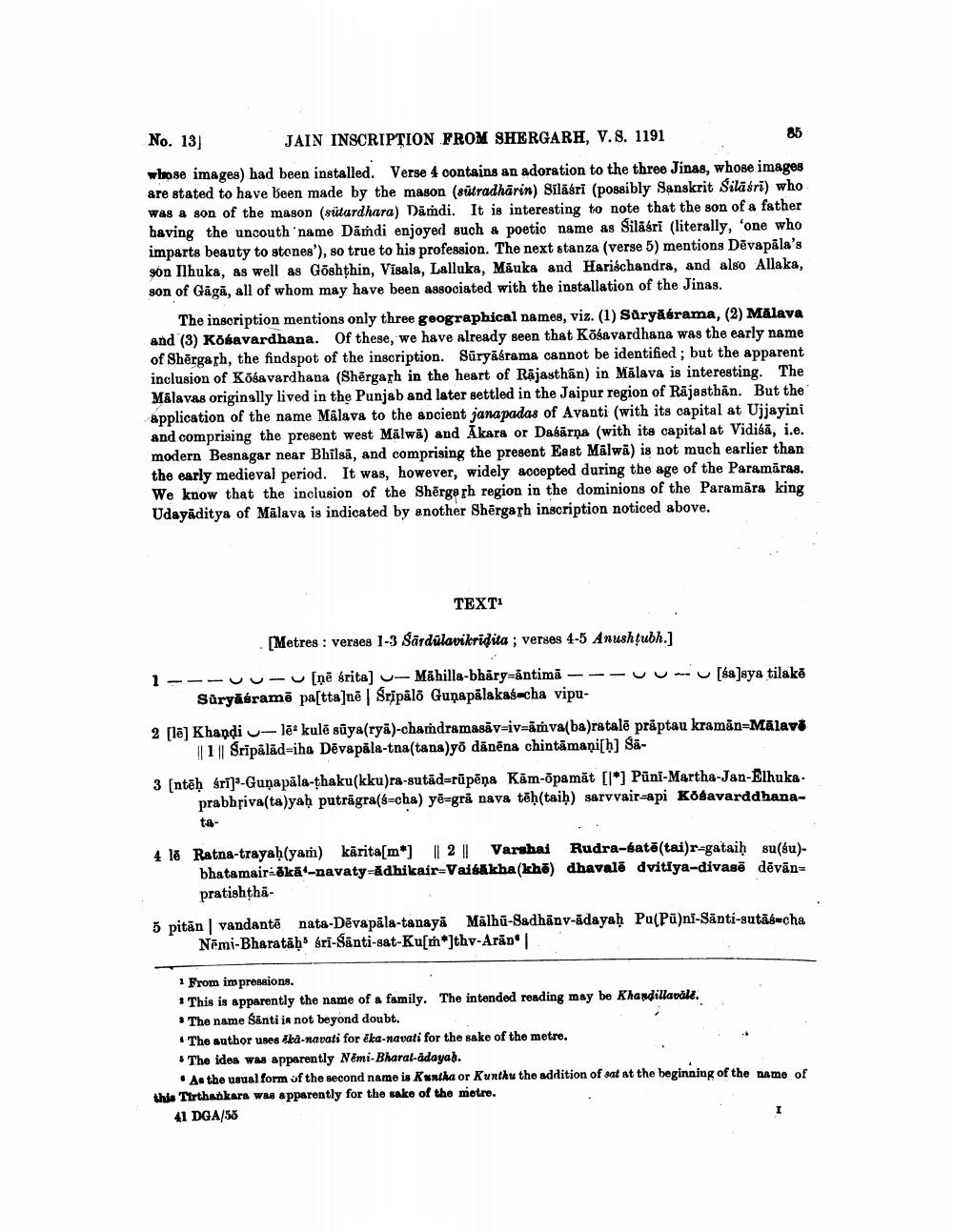________________
No. 13)
JAIN INSCRIPTION FROM SHERGARH, V. S. 1191
85
whose images) had been installed. Verse 4 contains an adoration to the three Jinas, whose images are stated to have been made by the mason (sutradhārin) Sīlāsri (possibly Sanskrit Silāóri) who was a son of the mason (sütardhara) Dāmdi. It is interesting to note that the son of a father having the uncouth 'name Dämdi enjoyed such a poetic name as Silāsri (literally, fone who imparts beauty to stones'), so true to his profession. The next stanza (verse 5) mentions Dēvapāla's son Ilhuka, as well as Goshthin, Visala, Lalluka, Māuka and Harischandra, and also Allaka, son of Gāgā, all of whom may have been associated with the installation of the Jinas.
The inscription mentions only three geographical names, viz. (1) Süryasrama, (2) Mälava and (3) Kosavardhana. Of these, we have already seen that Kösavardhana was the early name of Shērgach, the findspot of the inscription. Sūryāśrama cannot be identified; but the apparent inclusion of Kõsavardhana (Shērgarh in the heart of Rajasthan) in Mālava is interesting. The Mälavas originally lived in the Punjab and later settled in the Jaipur region of Rajasthan. But the application of the name Mālava to the ancient janapadas of Avanti (with its capital at Ujjayini and comprising the present west Mālwā) and Akara or Daśārna (with its capital at Vidisā, i.e. modern Besnagar near Bhilsā, and comprising the present East Malwā) is not much earlier than the early medieval period. It was, however, widely accepted during the age of the Paramāras. We know that the inclusion of the Shërgosh region in the dominions of the Paramára king Udayāditya of Mālava is indicated by another Shērgash inscription noticed above.
TEXT:
[Metres : verses 1-3 Šārdülavikridita ; verses 4-5 Anushțubh.]
1---UU- [nē brita) - Māhilla-bhāry=āntimā ---UU [sa]sya tilaka
Süryasramē pastta]nē | Sripālo Guņapālakascha vipu2 [lē] Khandi u lē: kulē sūya(ryā)-chamdramasāv=iv=āmva(ba)ratalē prăptau kraman-Mālavi
|| 1 || Srīpālād-iha Dēvapāla-tna(tana)yo dānēna chintamani[h] Sā3 [ntēḥ srīje-Guņapāla-thaku(kku)ra-sutād=rūpēņa Kām-õpamät [l*] Pūni-Martha-Jan-Elhuka
prabhpiva(ta)yah putrāgra(s-cha) yê=grå nava tēh(taih) sarvvair-api Kösavarddhana
4 lē Ratna-trayah(yam) karita[m] || 2 | Varsbai Rudra-satē (tai)r-gataih su(su)
bhatamair ēkāl-navaty-adhikair-Vaisakha(khô) dhavalē dvitiya-divasē dēvān= pratishtha
5 pitän vandantē nata-Dēvapāla-tanayā Mālhū-Sadhānv-ādayah Pu(Pū)ni-Santi-gutās cha
Nēmi-Bharatāḥ' sri-Sānti-sat-Ku[m*]thv-Arão
From impressions. * This is apparently the name of a family. The intended reading may be Khandillavale. * The name Sănti in not beyond doubt. • The author uses ika-navati for ēka-navati for the sake of the metre. The idea was apparently Nemi-Bharal-adayal.
As the usual form of the second name is Kuntha or Kunthu the addition of sat at the beginning of the name of thie Tirthankara was apparently for the sake of the motro.
41 DGA/58




